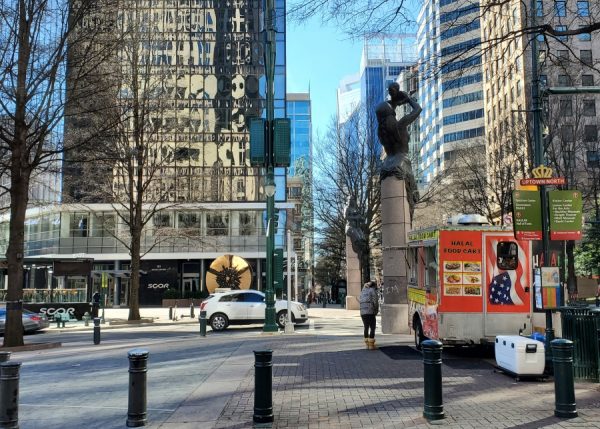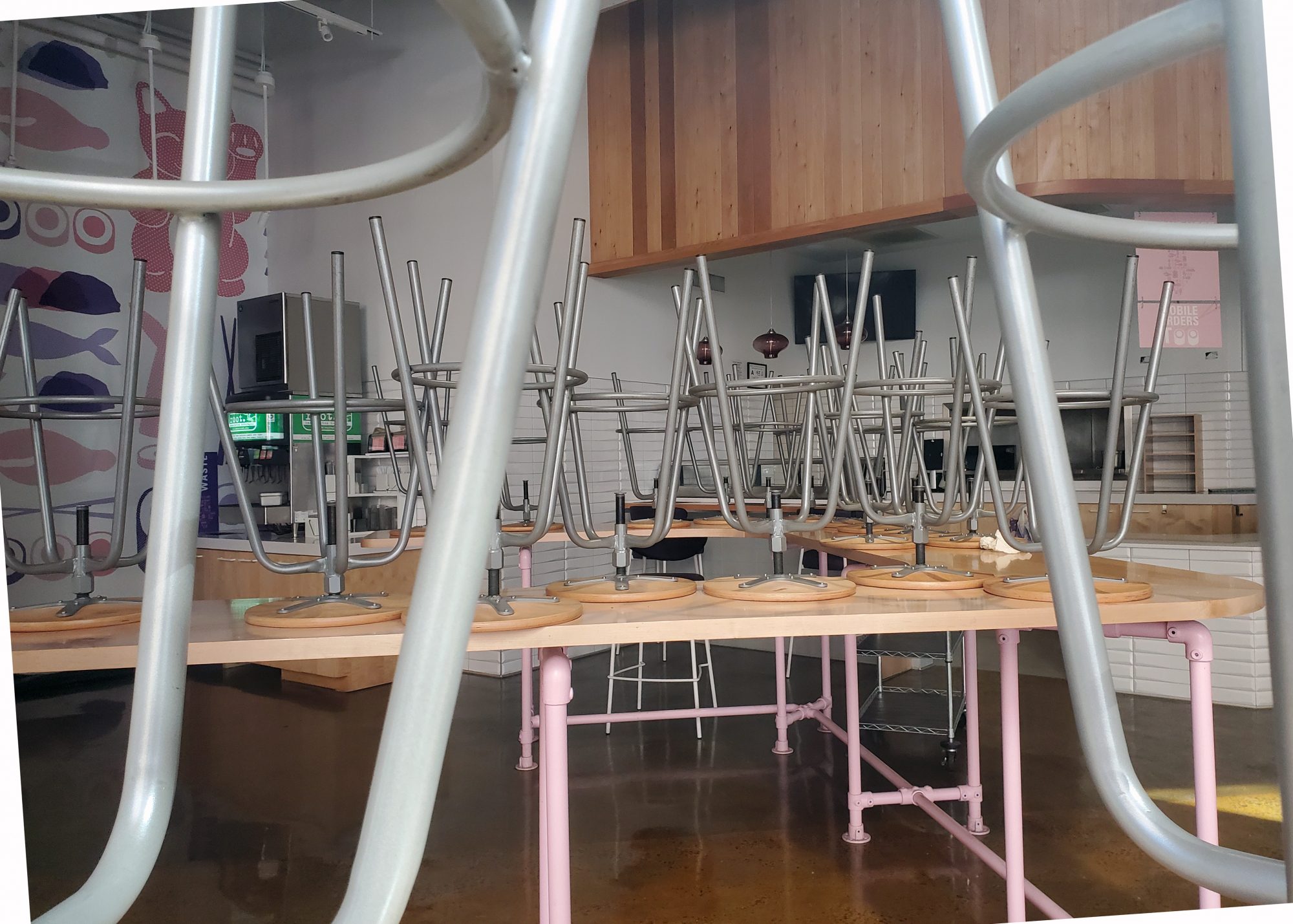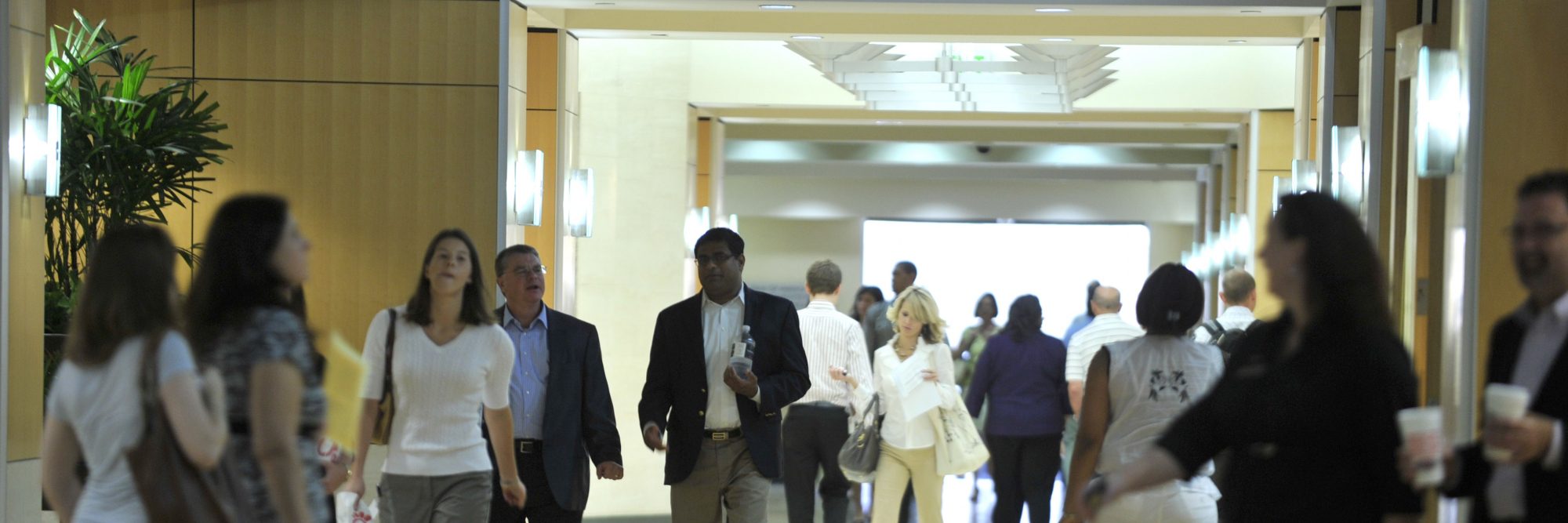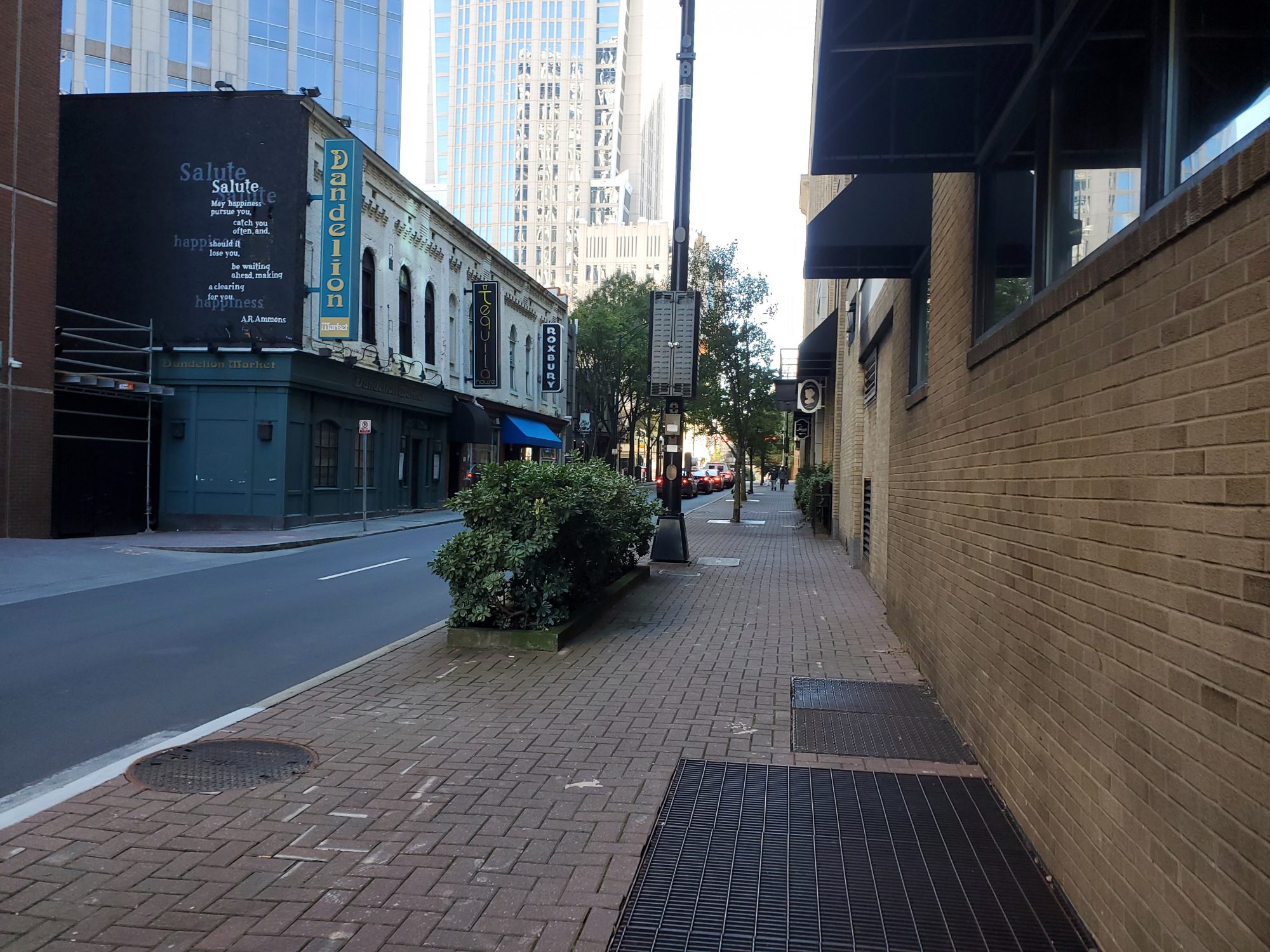What’s next for uptown once the pandemic fades?

A few minutes after noon on a recent Friday, a single customer waited for lunch at the Halal food cart parked on the sidewalk at Trade and Tryon streets.
A couple of workers in construction vests and a handful of security guards were the only other people in the plaza. The lunchtime crowd that would normally fill the streets with office workers taking the chance to stretch their legs in the mid-50s winter sun was nowhere to be seen.
Blocks away, a small gaggle of young men dressed in Charlotte-standard pre-pandemic banker wear (khakis and light blue-and-white checked shirts) strolled across Church Street. At uptown’s northern edge, dozens of tents from the newly prominent homeless encampment sprawled over several empty lots, colorful nylon shells belying desperation.
Nearly a year into the COVID-19 pandemic, most major employers are still keeping their workers home, attendance is limited at sports games and other events, and “Closed” or “Takeout Only” signs hang in front of many restaurants. The 125,000 or so office workers and thousands of visitors who fill uptown Charlotte’s skyscrapers and hotels every day – not to mention buying the sandwiches, drinks, Panthers, Knights, Hornets and Checkers tickets, concert series, museum passes and more that power the center city’s cultural life – are nowhere to be found.

Sukoshi Charlotte’s dining room uptown remains closed. Photo: Ely Portillo
Charlotte Center City Partners released their annual State of the Center City report on Thursday, detailing the continued growth uptown. Michael Smith, the organization’s CEO, emphasized that he thinks uptown, South End and Charlotte in general are primed for a resurgence.
“This has been an incredibly challenging year for our center city,” said Smith. “But I’m very hopeful.”
The numbers in Center City Partners’ report paint a picture of continued growth. Despite the pandemic, construction projects have remained on track. Uptown hasn’t been wracked by a wave of stalled buildings or empty condo towers, like after the 2008 crash and ensuing Great Recession.
There are 3.9 million square feet of office space under development in uptown and South End, along with 552,00 square feet of retail space, 5,505 new apartment units and 2020 hotel rooms in the works.
But two questions hang over the eerily open sidewalks, quiet restaurants, hushed office towers and near-empty Blue Line cars: When will everyone come back – and what happens if they don’t?
Let’s take a look at two possible scenarios – the bullish case and the bearish case – for uptown’s future in a post-pandemic world:
The bullish case: Back to the city
Picture this: It’s late 2021, and most people have been vaccinated. With the economy humming along, everyone rushes to make up for lost time. Office employees grateful to get away from their spare bedrooms or kitchen tables fill up the city’s skyline. Travel booms, concerts and sporting events sell out, and restaurants are full of people sick of takeout and huddling under heat lamps on patios.
That’s the scenario Smith and others who don’t subscribe to the “death of cities” thesis are counting on.
“I think there is incredible pent-up demand,” said Smith. “I’m dying to go out and hear live music.”
And Charlotte, Smith said, will be in a great position to win more business when that demand returns. High-profile relocations like Honeywell and expansions like Lowe’s new South End tower had the city on a roll, and that could well continue.
“I have a deep belief that in the recovery Charlotte will be positioned better than our competitors,” said Smith.

Workers fill Overstreet Mall uptown, on an afternoon before the pandemic. Photo: Nancy Pierce
Class A office rents in uptown average $38.64 per square foot, according to Center City Partners. That’s less than the national average of $42.15, and much less than some competitors like Austin, Tex., at $65.34. Along with decent weather, its well-connected airport, a lower cost of living than top-tier coastal cities like New York and San Francisco, Charlotte could be the beneficiary of workers and companies fleeting the highest cost “superstar cities.”
“Superstar pain could be America’s gain—not only because lower housing costs in expensive cities will make room for middle-class movers, but also because the coastal diaspora will fertilize growth in other places,” The Atlantic theorized recently. “As home values decline in the superstar cities, they’re rising in major Sun Belt metros.”
And despite the rise of remote work, Smith still thinks there’s a major place for the collaboration, sharing, mentorship and talent development that happens in-person.
“When you talk to major employers, they keep coming back to the fact that the core of a company is often its culture, and people and you have to bring people together to share culture and build on culture…We’ve not figured out how to do it this way,” he said, gesturing at a Zoom window.
Smith’s optimism isn’t just based on people wanting to come back and hear live music. He also points to those 3.9 million square feet of office space, thousands of apartments and other development projects as evidence of uptown’s resiliency. In all, more than $3 billion worth of development is planned for 2021.
“That’s a big bet,” he said, and the billions of dollars being investment mean companies will have a big incentive to make sure their buildings get filled. “Institutional investors are still subscribing to the promise of this city. Their timeline is not one year, 18 months, 36 months.”
Plenty of observers agree. Crucially, the financial sector at the heart of uptown’s job market isn’t hemorrhaging jobs like it did during the Great Recession. Brokerage firm JLL, in a recent prediction for the office market, painted a bright picture:
“In the post-vaccine world, the Charlotte office market will be one of the first office markets to stage a recovery. The market has a solid foundation buoyed by growing office sector employment and surging population growth. The same conditions that made Charlotte one of the top destinations for corporate relocations and expansions remain.”
The bearish case: A part-time urban core
Now, picture this: It’s late 2021, and vaccine rollouts have been slow, with lots of people refusing the shot. Even among those who’ve been vaccinated, there’s little enthusiasm to return to full-time, five-day-a-week office work, and hybrid schedules with two or three days a week in the office, two or three days a week remote, has become the norm. Travel remains sluggish, and restaurants, sports teams and concerts still can’t fill their seats.
The end result is a much smaller daytime population in uptown Charlotte, with only about half the average daily workers coming to work on a given day, which leaves plenty of secondary businesses struggling. There are about 18,300 residents in uptown – far more than a decade ago, but only about 15% of the number of daily workers in Center City.

Fifth Street deserted during the noon lunch hour. Photo: Ely Portillo
No one’s quite sure what cultural shifts after the pandemic will be temporary and which are with us forever. There’s anecdotal evidence that people spent 2020 investing more in their home offices, and Charlotteans got an average of 46 hours back they would have lost sitting in traffic last year – but what does that mean for how often we’ll be commuting in to work in 2025? And does uptown still work with half its current daytime population on any given day?
Even if it’s not the “death of cities,” such hybrid work shifts could make for a lot less vibrancy.
Some companies have already made the switch permanent, like Salesforce, the San Francisco-based tech giant which announced this week that “the 9-to-5 workday is dead” and that the vast majority of its employees will either be fully remote or only expected to come in to the office a couple days a week going forward.
It’s easy to spin the effects forward into more “what if?” scenarios. Take business travel. Passenger traffic fell by nearly half in 2020, Charlotte Douglas said, and airlines are expecting the recovery to take years. As a hub where roughly 70% of passengers connect from one plane to another, Charlotte is especially dependent on pricey business travel.
But do business travelers want to hit the road again – at least as often as they used to – or would they rather keep doing more virtual sales calls, travel when only absolutely necessary, and spend a lot more time at home with their families? It’s a question with huge implications for both Charlotte’s economic development ace-in-the-hole (the city’s airport) and the local hotel industry (in Philadelphia, developers just announced a business traveler-focused Embassy Suites downtown will be converted to apartments because demand isn’t expected to rebound for a long time).
And that’s just one question of the dozens facing uptown, and Charlotte. Will people return to mass transit? Will companies want to radically downsize their office space? How many restaurants can survive another year of covid?
Smith admits there will be a “next normal,” and that is likely to involve flexible work schedules and less butts-in-office-chairs time for workers.
Still, he fully expects a return to Charlotte’s center – even if it takes a while.
“I don’t know what it will look like in 10 years,” he said. “But I know, over time, density will return.”